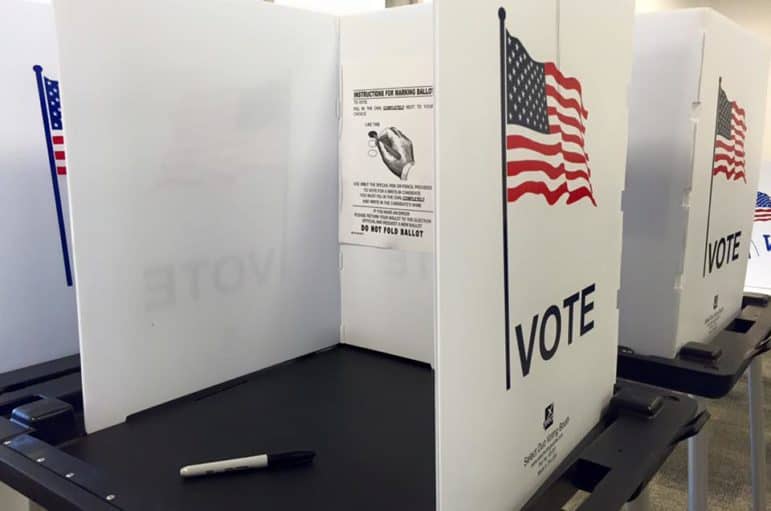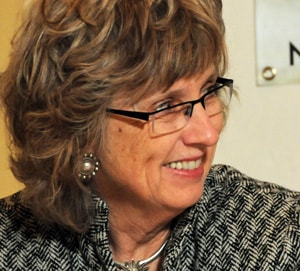
Heath Haussamen / NMPolitics.net
A voting kiosk
(COMMENTARY) To recap:
A few weeks ago the New York Times published an anonymous op-ed piece written by a senior White House official exposing a president so unhinged and detached from reality that a number of his top aides had banded together to protect the country from his irrationality. The piece was followed shortly by Bob Woodward’s new book, Fear, which included on-the-record quotes and further evidence of same.
As Woodward was making the rounds of news shows and eliciting shocked reactions, another story began to break: Christine Blasey Ford’s account of how Brett Kavanaugh attempted to rape her at a 1980s high school party in the Maryland. The story prompted a harsh reaction from Republicans, then on the verge of confirming Kavanaugh; an initial refusal to delay; and then an election year tip-of-the hat to the “Me Too” movement and women who demanded that she be heard.
Without even allowing the FBI investigation accorded to Anita Hill in 1991, Chairman Grassley said Ford could say her piece — but only when the proper optics were assured: no witnesses under oath, no harsh questioning by white male Republican senators themselves, no ability to refute Kavanaugh’s testimony by following him on the witness stand. Facing almost certain humiliation, Ford courageously agreed.

Heath Haussamen / NMPolitics.net
Dede Feldman
Then, as Democrats and Republicans dug in, another story of possible sexual abuse surfaced in the New Yorker. It was dismissed as a partisan smear campaign without an official investigation.
That story too was eclipsed as arguably the most important figure (other than Mueller himself) in the Russia investigation seemed on the verge of an exit from the Justice Department after he was accused of encouraging others to wear a wire at the White House and to invoke the 25th Amendment. “The stench will soon be removed,” Trump told his followers. The looming firing of Rosenstein, who has called the accusations inaccurate, is widely seen as an attempt to end the Russia investigation.
That’s just three weeks, folks! I recount it here to remind you of the chaos that surrounds us. It’s the build-up to the fall elections, perhaps — but it’s not easy to keep your eyes on the ball. For me, the “ball” is the coming elections and the Republican Party’s willingness to “plow through” and appoint an alleged sex abuser to a lifetime Supreme Court post without a thorough, official investigation.
Will this have an effect on the election — and on the American people? Or will we accept it as more of the same from Trump and the Republican congressional majority, who seem to have forgotten how to stand up for any moral value except that of continued political power?
Pity parties are not always what they seem
During the 1980s, I spent a lot of my time helping pioneering women who dared to run for political office in New Mexico. It was a different time. Women candidates — both Republicans and Democrats — had difficulty raising money and gaining credibility. Legislatures, the governors’ mansions and Congress were a man’s world.
During the first “year of the woman” in 1984 we had our hopes raised — and dashed — by Geraldine Ferraro, the first woman on a national ticket. Then in 1991 came the Anita Hill hearings, and like other activist women in the 1980s, I was glued to the TV, heartbroken by her treatment.
In the wake of Clarence Thomas’s confirmation, a number of women in Albuquerque, mostly Democratic lawyers, judges and professionals, held a “Bitch and Moan” party at my house, a potluck, where we served comfort food, consoled each other, took out our checkbooks, rolled up our sleeves and vowed to not let this happen again.
Here’s what happened in the next two years. The number of women in the N.M. Senate doubled from four to eight. In the N.M. House the number increased from 12 to 14. Women began in earnest to run for state courts, building on the pioneering work of Mary Walters, Patricia Madrid, Susan Conway and Pamela Minzer. Now, women compose 16 of the 27 judges in Albuquerque’s Second Judicial District Court and 13 of 19 of those on the city’s Metro Court. If just two of the women running for the N.M. Court of Appeals win this year, a majority on that court will be women. Three of five state Supreme Court justices are already women.
On the national level, 24 women won congressional seats in 1992 and 11 won in the Senate, including Sens. Patty Murray and Diane Feinstein, who are outspoken critics of how the Kavanaugh nomination is being handled today. Back in New Mexico we had a record number of women running for local government posts as well — Pauline Gubbels and Millie Santillanes for mayor in Albuquerque, and Debbie Jaramillo, who became Santa Fe’s mayor in 1994.
In 1991 many of the women who gathered for my Bitch and Moan party would go on to be legislators, judges and other public officials. We didn’t mourn for long. We organized. Now, faced with an even more potent threat to basic women’s rights and dignity, we’ve got to redouble our efforts.
Signs were already good for 2018 to be another “Year of the Woman” — but now it’s up to us. This time we are strengthened by emerging pipelines for new pro-choice candidates. And we are joined by our daughters and granddaughters.
Before she joined the N.M. Senate in 1997, Dede Feldman spent the 1980s as a member of the bipartisan Women’s Political Caucus, worked on the campaigns of Rep. Judy Pratt for U.S. Senate, Suzanne Brown for APS School Board and Teresa Baca for District Court judge, among other candidates. Agree with her opinion? Disagree? NMPolitics.net welcomes your views. Learn about submitting your own commentary here.